
Best Light for Plant Growth
We all know that light is crucial for plant growth, but many growers don’t know what to look for when choosing light bulbs, or why their plants need a specific type of light. In this article, we’ll cover why plants need light, and the best type of bulbs for plant growth.
Photosynthesis is the process through which plants turn water and carbon dioxide into their food (sugar) in the presence of sunlight. Plants take in carbon dioxide from the air through openings in the leaves and convert it to sugar during photosynthesis. Chlorophyll is the green pigment in plants that makes it possible for them to create their own food, and it also gives plants their green color. Water is necessary for plants to undergo photosynthesis, and plants absorb it through their roots. Oxygen is released back into the atmosphere as a by-product of photosynthesis.
The light duration, or the amount of time the plant is exposed to the sunlight, is important as well. The duration of light changes with the seasons. This affects the temperature of the environment as well. Summer has the longest duration of sunlight, followed by spring and fall, and winter has the shortest duration of sunlight. Not all plants need the same amount of light. Plants that produce fruit, such as tomatoes, tend to need more sunlight than those that do not. For example, strawberries need more sunlight than lettuce to grow. Fruiting plants grow best in summer, and may need up to 18 hours of light per day to flower and produce fruit. On the other hand, some plants, such as cauliflower and cabbage, grow well in late fall and need as little as 12 hours of light per day.
Let There Be Light
The electromagnetic spectrum is the range of wavelengths or frequencies over which electromagnetic radiation extends. The electromagnetic spectrum consists of both the visible spectrum, the type of light we can see, and the infrared spectrum, the type that we cannot see. The four seasons have different durations of light, which can affect photosynthesis. There are certain colors of light that are more important for photosynthesis than others. Plants are adapted to absorb and utilize the proper amount of light in order to grow naturally outdoors.
When growing plants indoors, we must recreate the light produced by the sun, keeping two important factors in mind: color temperature and duration. The temperatures of the colors on the electromagnetic spectrum are measured in Kelvin.
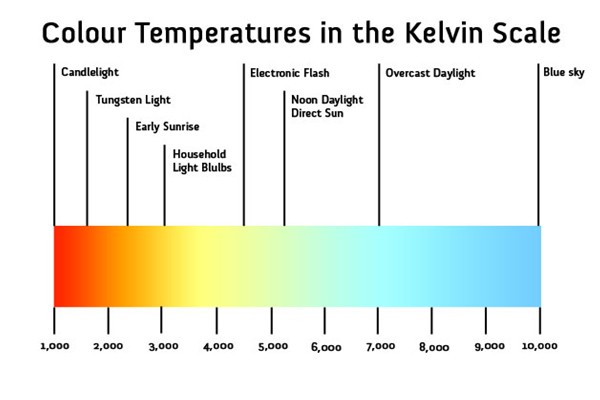
Take a look at the diagram above. Plants grow best when they are exposed to light that is as similar to natural sunlight as possible, which is between 2,700 and 7,000 Kelvin. In the old days, growers would use red- and blue- colored LED’s to give plants this full spectrum of light that they need to grow. The only reason that red and blue LED’s were used, is because white LED’s that provided the necessary spectrum and brightness did not exist yet. However, with new technology it is entirely possible to get the full spectrum and brightness of light that plants need, 2,700 to 6,500 degrees Kelvin, with white LED lights. White LED’s use the least amount of power and last the longest, and grow plants just as well as every other kind of light available today.
Not only is using red and blue lights unnecessary, it can actually disrupt sleep and make some people feel sick. Blue light affects the body’s levels of the sleep-inducing hormone melatonin more than any other wavelength, which is why it is recommended to avoid electronic devices before bed.
What Type of Light Bulbs to Buy
The most common type of grow-light bulb is the T5 & T8 LED Tube Light. The bulb is most often found in (more or less) 6,500 Kelvin, which is the color temperature of the light we see at daylight. Traditionally, blue lights would be used to provide plants with this necessary wavelength. Plants undergo vegetative growth during daylight hours, so this light is beneficial to plants during the vegetative stage of growth.
Bulbs that are ~2,700 Kelvin are beneficial to plants in the flowering and fruiting stages of growth. This is the color temperature during sunrise hours of the day. Bulbs that are 2,700 to 2,700 Kelvin are traditionally warmer in color, with more red and orange tones. The red lights used by some growers would deliver this color-temperature to plants.
Both the 2,700 and 6,500 Kelvin lights are available as white LEDs, so there is no need to use red or blue lights anymore. We recommend using fixtures that hold four bulbs, and alternating the 2,700 and 6,500 Kelvin bulbs in the fixture. This will ensure that plants receive the benefits of both.
Other Lights Bulbs
The LED lights are also available in 4,100 Kelvin and 10,000 Kelvin. While you may never need either of these types of bulbs, they are worth mentioning. Bulbs that provide 4,100 Kelvins are neutral-looking lights, and will promote leaf and stem growth. This type of light would not do much for plants in the vegetative or flowering stages of growth.
The light bulbs used above aquariums are typically 10,000 Kelvin. Notice on the diagram that this is the bluest light in the electromagnetic spectrum. This is also similar to the spectrum of light that is visible deep underwater, which makes it useful for growing aquarium plants or raising fish.

Attracting Beneficial Insects

What Causes Leggy Seedlings

How to Harden Off Your Seedlings

When to Transplant Seedlings
Trackbacks and pingbacks
No trackback or pingback available for this article.
18 comments
Leave a reply Delete Message
Articles
Featured
-
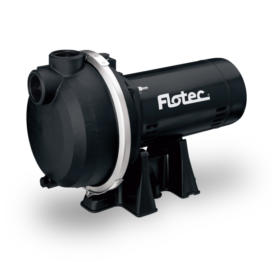 Thermoplastic Irrigation Pump 1 HPRegular Price $469.99
Thermoplastic Irrigation Pump 1 HPRegular Price $469.99 -
 Drain Dish & Diffuser Dish Set 10 PackRegular Price $124.99
Drain Dish & Diffuser Dish Set 10 PackRegular Price $124.99 -
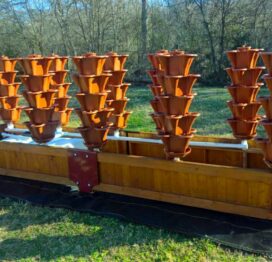 Ten Tower Deck GardenRegular Price $3,499.00
Ten Tower Deck GardenRegular Price $3,499.00 -
 EzGro Quad Pot 50 PackRegular Price $499.90
EzGro Quad Pot 50 PackRegular Price $499.90 -
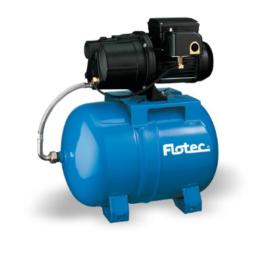 Rainwater Pressure Tank SystemRegular Price $449.00
Rainwater Pressure Tank SystemRegular Price $449.00 -
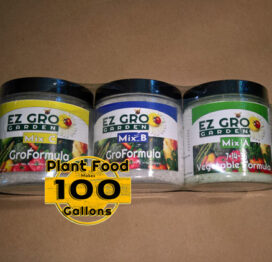 Vegetable Formula single dose SetRegular Price $29.99
Vegetable Formula single dose SetRegular Price $29.99 -
 EzGro Precision Micro TrimmerRegular Price $11.99
EzGro Precision Micro TrimmerRegular Price $11.99 -
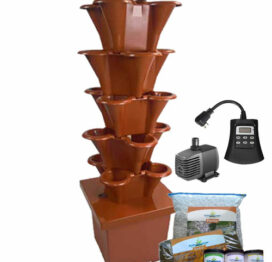 EzGro Patio GardenRegular Price $389.99 – $399.99
EzGro Patio GardenRegular Price $389.99 – $399.99 -
 Outdoor 3 Outlet Smart Plug TimerRegular Price $39.99
Outdoor 3 Outlet Smart Plug TimerRegular Price $39.99 -
 Drain Dish & Diffuser Dish Set 5 PackRegular Price $69.95
Drain Dish & Diffuser Dish Set 5 PackRegular Price $69.95









This article is the best one I have read on the subject of plant growth using LED lights. The others talk about incandescent, halogen, flourescent, etc, but do not mention LED's, which are now commonly available in white light and are not as costly as they once were.
I do have one question. I am overwintering some of my houseplants, which did great in our coastal Carolina summer weather that is typically hot, humid, wet (sometimes) and features lots of sunlight. I purchased a 5000K white GE LED and a 2500K GE LED. I have these plants on a long table covered with aluminum foil for reflective purposes, with the 2500K LED at one end of the table and the 5000K LED at the other side. Both are in gooseneck fixtures. Together, these LED's bathe the plants in very bright light. I have them on for 16 hours/day, using timers, with the 2500K bulb turned on about one hour before the 5000K bulb and remaining on about 1/2 hour after the 5000K bulb goes off, in my crude attempt to simulate first and last light. During the intervening hours, they are on simultaneously.
May I ask, do you think this is a suitable set-up? I could not find a 6500K LED, but the 5000K simulates direct sunlight at noon, according to your article, which I figure is good light.
Any light you can shed on my set-up's suitability or lack thereof would be greatly appreciated. I love my plants and want to do the best by them.
Thank you,
Ken H.
Wilmington, NC
The short answer is what you are doing will work. Do keep in mind more light is always better and when you don’t have enough light then leave them on longer. I am assuming you don’t have flowering plants. Most house plants are all foliage and no flowering. If that is the case then you can use just the 5000k lights and don’t really need the 2500k because the 2500k promotes the flowering and fruiting growth. The 5000k promotes the foliage growth and supports the flowering some. At this point I would keep doing just what you are doing and if you find they start waning you can add another one or two 5000k and/or extend the duration of the lights on time.
Hi, there!
We happen to.have several flat panel LED lights left over from a construction buildout that I would like to use for starting some seeds.
They are dimmable 5500/4100/3400 Lumens and are 3500K. Do you think this fixture will suffice to start plants? My dear man built me a greenhouse which I heat at night, but the angle of the sun in March leaves a little to be desired.
Any help would be greatly appreciated as I am an experienced gardener but a newbie to starting seeds and to the greenhouse considerations.
Thanks!
Liz M
Those should work for you and any time you can repurpose it is a good thing. If you haven't already read the articles in Growing Tips they will help on your success starting seedlings.
Aloha,
Thanks for a really useful and simple explanation. I am trying out a led rope light on my lanai ( vegetable grow shelves). I had a heck of a time finding the lumens. However, I found the kelvin and it is spec'd at 2700. From reading your site, it seems I did well picking something that will help me. Thanks again,
Tom
This is one of the best article regarding usinging led bulb for plants. 5 star *
Kudrat
Dhaka, Bangladesh
agreed most helpful article on lights so far-thank u!
Can I possibly use LED strips instead of light bulbs?
Yes you can.
I started my auto with full spectrum light the are looking sickly so I installed a 2700k led will this help thanks
Is this guide applicable to any LED bulbs/strips or only horticulture-specific bulbs?
Thanks!
This will work with pretty much any lighting.
I finally get it. Thanks for the childlike breakdown. Where were you 3 hours ago?
I’m a filmmaker and have many 14inch square LED panel video lights which have easy knobs on the back for adjustable colour temperature (3200-5600) and intensity — and also run on typical video production V-Lock camera batteries which are rechargeable. The pandemic has shuttered a lot of filming work, put many jobs on hiatus. My adorable lady palms in my lounge room, which are starved of a bit of light in the Southern Hemisphere winter, now love these lights. Normally the actors or interviewees are being lit by them, now the plants are, and they feel like movie stars. They actually look like ones too.
Excellent article for people like me trying to learn and understand the different aspects of lighting in relation to growing very easy to understand and I can honestly say I learned something from this article unlike the other 6 or so articles I have just read on various other sites. Thanks for sharing this with us, two big thumbs up from me..
Best article on the internet on grow lighting. Thank you!
hello!, what about 2200k? I have a led with two spectrums, it has 2200k and 5000k. It is a good spectrum to grow and flowering my plants? please i need your help!!!!
Yes the 2200k is good to use for your plants.